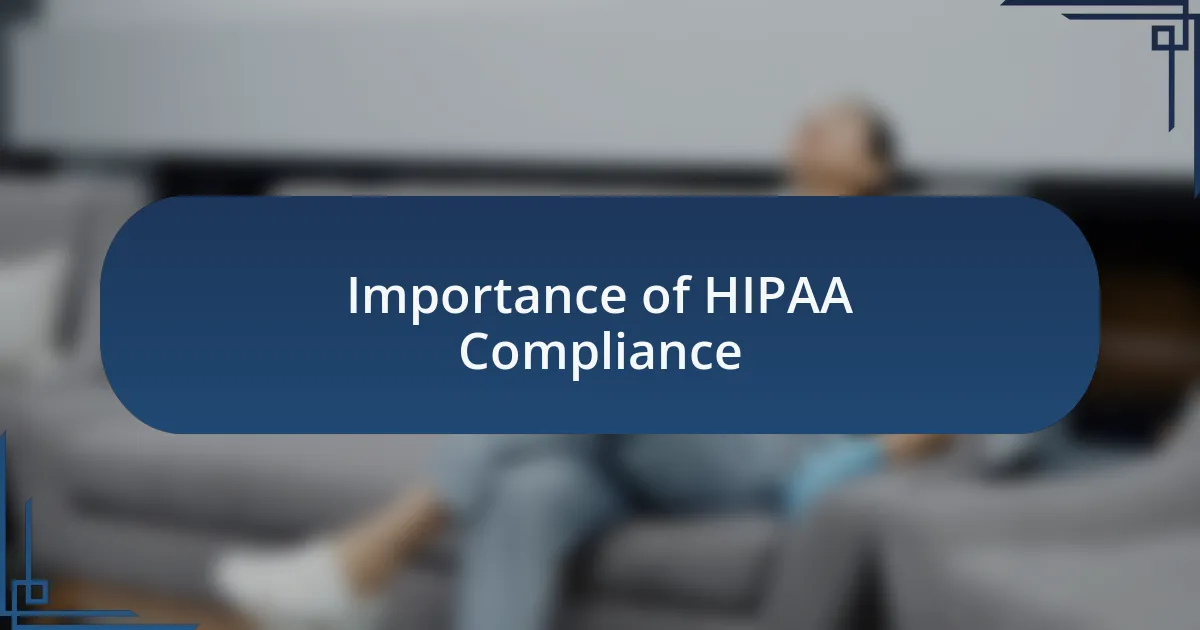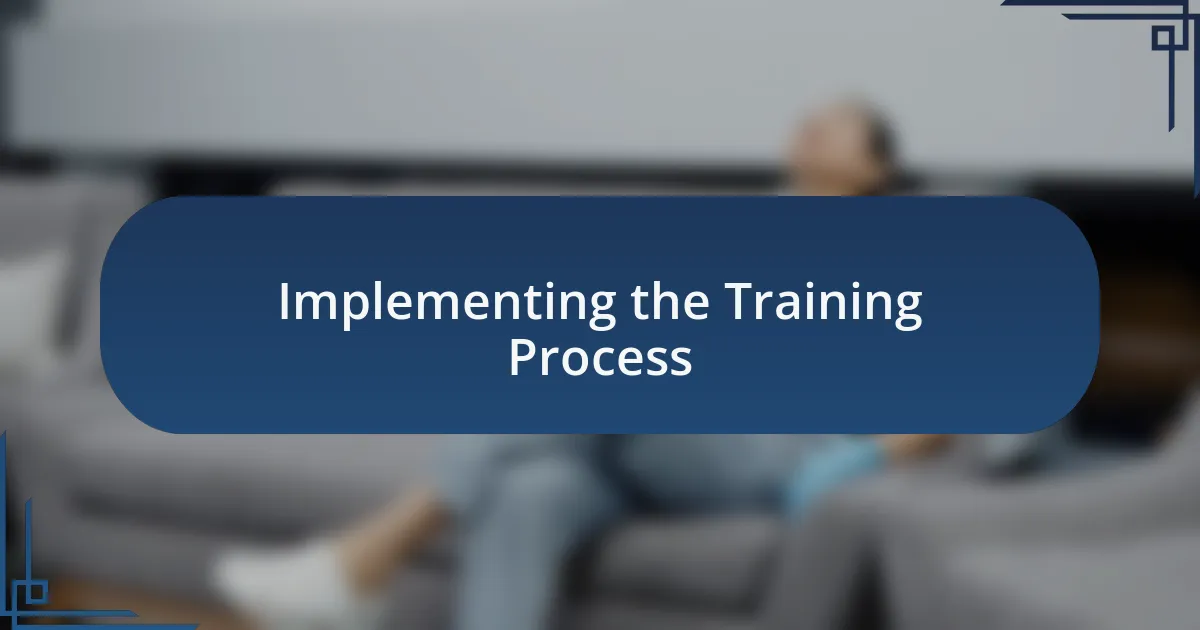Key takeaways:
- HIPAA training is essential for safeguarding patient information and fostering trust between healthcare providers and patients.
- Ongoing education and interactive training formats, such as role-playing, enhance understanding and compliance retention.
- Developing a tailored training plan driven by team needs and incorporating real-world scenarios promotes engagement and effectiveness.
- Measuring training effectiveness through quizzes, behavior changes, and follow-up discussions ensures long-term retention and accountability.

Understanding HIPAA Training
HIPAA training is essential for anyone working in healthcare because it lays the groundwork for safeguarding patient information. I remember my first day on the job when I was faced with the overwhelming responsibility of handling sensitive data. The training not only clarified what constitutes protected health information (PHI) but also instilled a sense of duty to protect patient confidentiality, which ultimately shapes the trust between providers and patients.
As I navigated through the complexities of HIPAA regulations, I found the interactive formats particularly engaging. Participating in role-playing scenarios helped me visualize the real-world implications of breaches. Have you ever thought about how a simple mistake, like leaving a computer unlocked, could lead to significant fines and damage to your organization’s reputation? That realization hit home during my training and underscored the importance of vigilance in maintaining compliance.
Additionally, HIPAA training is not a one-time event; it requires ongoing education. I recall attending refreshers that highlighted new threats and compliance challenges. It made me realize that staying informed is crucial in a landscape where technology constantly evolves. What strategies can you adopt to ensure your knowledge remains up-to-date? For me, regular workshops and sharing insights with colleagues became invaluable in fostering a culture of compliance and awareness.

Importance of HIPAA Compliance
HIPAA compliance is vital for maintaining the trust that patients place in healthcare providers. I vividly recall a patient expressing relief when I assured them their data was secure. That moment emphasized how essential it is for us to protect not just the information, but the very relationship we build with those we serve. Without steadfast compliance, we risk not only hefty fines but also the deterioration of that trust, which can be irreparable.
Moreover, the legal ramifications of non-compliance can be staggering. There was a time in my career when I witnessed a colleague facing repercussions for an inadvertent error that breached HIPAA guidelines. It was a stark reminder of how fragile our positions can be if we don’t adhere to the laws governing patient privacy. Have you ever considered what would happen if you were held accountable for a compliance failure? The sheer weight of that responsibility compels us to view HIPAA not just as a mandate, but as a fundamental aspect of ethical healthcare delivery.
Finally, ensuring HIPAA compliance also guards against cybersecurity threats that have become increasingly common. I remember attending a seminar where an expert highlighted the rising trend of data breaches and how easy it can be for a healthcare provider to become a target. How often do you think about the security of patient information in the digital age? This realization pushed me to invest more time in understanding safeguarding techniques, reinforcing that compliance helps protect against not just legal issues but also the very data that patients trust us to safeguard.

Overview of HIPAA Training Programs
HIPAA training programs are designed to equip healthcare professionals with essential knowledge about patient privacy and data security. Having participated in numerous training sessions, I can recall one particular workshop that profoundly impacted my understanding of patient rights. The facilitator shared real-world examples of how simple missteps could lead to serious breaches, making me acutely aware of my responsibilities.
These programs typically cover a range of topics, from the fundamentals of HIPAA regulations to specific protocols for safeguarding sensitive information. I remember a scenario where a colleague struggled to recall protocol during a critical moment; that’s when the value of comprehensive training became crystal clear. Could a brief online module have prepared them better? It’s an important consideration as we reflect on the effectiveness of training formats.
Moreover, the interactive nature of many HIPAA training programs ultimately enhances retention of the information. I personally found role-playing exercises to be incredibly valuable, as they allowed me to practice responding to potential compliance challenges in a safe environment. Have you ever thought about how simulation can prepare you for real-life encounters? Engaging with the material in such a dynamic way helps solidify our understanding of HIPAA obligations and boosts confidence, making the learning experience both memorable and beneficial.

Developing a Training Plan
When developing a training plan for HIPAA compliance, it’s crucial to start by assessing the specific needs of your team. In my experience, conducting a needs assessment not only highlights potential gaps in knowledge but also allows team members to express their concerns and expectations. Have you ever sat down with your colleagues to discuss what they actually want to learn? This dialog can be incredibly revealing and helps tailor the training to be more relevant and effective.
Next, the structure of the training is equally important. I once encountered a program that was too rigid and theoretical, leaving participants overwhelmed. A more flexible approach—such as mixing online modules with in-person discussions—might resonate better with various learning styles. By incorporating feedback loops, I found that we could tweak the content on-the-fly, enhancing engagement and understanding. How might varying formats keep your team motivated?
Lastly, it’s essential to include ongoing assessments to evaluate the effectiveness of the training plan. After implementing quizzes and practical scenarios, I noticed that participants were more engaged and retained information better. It’s fascinating how frequent assessments not only highlight what needs revisiting but also reinforce the training. Have you thought about how continuous feedback could shape a robust compliance culture? Reflecting on these aspects can inform the evolution of your training strategies.

Implementing the Training Process
Implementing the training process begins with establishing a timeline and milestones for each phase. When I recently rolled out HIPAA training, I found it helpful to break the implementation into manageable steps. This way, both the trainers and participants could track progress more easily and celebrate small victories along the way. Have you ever noticed how little achievements can boost morale?
Incorporating real-world scenarios was a game changer during my training sessions. I remember one specific example where we role-played a data breach response. This hands-on simulation sparked lively discussions and made the concept of compliance feel tangible. It’s astonishing how experiential learning can bridge the gap between theoretical knowledge and practical application. Wouldn’t it be rewarding to see team members genuinely grasp the stakes involved?
Finally, as we wrapped up training, I made it a point to emphasize the importance of open communication. I encouraged participants to share their thoughts not just during the training but afterward, too. This approach fostered a culture where everyone felt comfortable discussing HIPAA-related concerns. It’s a simple yet profound experience—seeing colleagues transform from passive listeners to active participants in compliance. How do you foster that level of engagement in your training sessions?

Measuring Training Effectiveness
To effectively measure the success of HIPAA training, I implemented a combination of quizzes and feedback forms. After each session, I had participants complete a short quiz that not only tested their knowledge but also revealed areas where they felt uncertain. The real eye-opener came when I reviewed the feedback—sometimes, people expressed confusion about topics I assumed were clear. Have you ever found that what seems simple to you might be complex to others?
Another method I used was tracking changes in behavior over time. I asked team leaders to observe how employees applied their training in day-to-day tasks. One leader reported a noticeable decrease in security-related incidents, which felt incredibly validating. Doesn’t it make you realize how tangible results can showcase the impact of training?
Lastly, I facilitated group discussions six months post-training to evaluate retention and application of the concepts learned. During these sessions, it was gratifying to witness team members confidently share their understanding and promote best practices. It was evident that this ongoing dialogue created a sense of accountability. How do you ensure long-term retention in the training you conduct?

Personal Insights and Lessons Learned
Reflecting on the implementation of HIPAA training, I discovered that engagement is critical. I vividly remember one session where an unexpected dialogue erupted around data sharing. Witnessing my colleagues passionately voice their concerns illuminated the gaps in my assumptions about their understanding. Have you ever found yourself surprised by the depth of issues others care about?
Another lesson I learned was the importance of creating a safe space for questions. In one instance, an employee hesitated to ask about a particular policy, fearing it might seem trivial. After encouraging an open atmosphere, several participants thanked me for fostering an environment that welcomed curiosity. When have you felt empowered to ask questions, knowing they would be received with interest rather than judgment?
Finally, I realized that follow-up is just as crucial as the training itself. A few weeks after our sessions, I reached out individually to see how everyone was applying what they learned. The feedback was enlightening; some felt confident, while others still grappled with certain concepts. How do you stay connected with your team after a training session to ensure ongoing support?